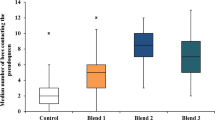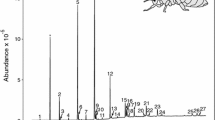Abstract
In a series of husbandry and stop-time chemical experiments with honey bee queens, the production of tergal gland alkenes was found to be stimulated by natural mating and not by instrumental insemination. Carbon dioxide, physical manipulation of the sting chamber and vagina, presence of sperm in the spermatheca, egg production, and chemicals transferred via drone semen are demonstrated to not initiate the synthesis of the tergal gland alkenes. The compounds probably do not function as sex pheromones. However, the circumstances and timing of the initiation of production of the tergal gland alkenes strongly suggests a communication role for the compounds within the hive.
Similar content being viewed by others
References
Caron, D.M., andGreve, C.W. 1979. Destruction of queen cells placed in queenrightApis mellifera colonies.Ann. Entomol. Soc. Am. 72(3):405–407.
De Hazan, M.Y., Lensky, Y., andCassier, P. 1989. Effects of queen honeybee (Apis mellifera L.) ageing on her attractiveness to workers.Comp. Biochem. Physiol. 93A(4):777–783.
Espelie, K.E., Butz, V.M., andDietz, A. 1990. Decyl decanoate: A major component of the tergite glands of honeybee queens (Apis mellifera L.).J. Apic. Res. 29(1):15–19.
Harbo, J., andSzabo, T. 1984. A comparison of instrumentally inseminated and naturally mated queens.J. Apic. Res. 23(1):31–36.
Laidlaw, H.H., Jr. 1977. Instrumental Insemination of Honey Bee Queens. Dadant & Sons, Hamilton, Illinois.
Nation, J.L., Sanford, M.T., andMilne, K. 1991. Comparison of cuticular hydrocarbons from Varroa mites and honey bees.Am. Bee J. 131(12):778–779.
Page, R.E., Jr., Metcalf, R.A., Metcalf, R.L., Erickson, E.H., Jr., andLampman, R.L. 1991. Extractable hydrocarbons and kin recognition in honeybee (Apis mellifera L.).J. Chem. Ecol. 17(4):745–756.
Smith, R.-K. 1987. Identification of Africanization in honey bees based on extracted hydrocarbons assay. Presented at the Second International Conference on Africanized Honey Bees and Bee Mites, Ohio State University, Columbus, Ohio, March 30-April 1.
Smith, R.-K., Rossman, F.R., York, H.F. Jr., andTaylor, O.R. Jr., 1988. Stock certification of European Queens.Am Bee J. 128:676–678.
Smith, R.-K., andTaylor, O.R. Jr. 1988. Determination of Africanization in Honey Bee Queens. Am. Bee J. 128(12):808–809.
Smith, R.-K., andTaylor, O.R., Jr. 1990. Unsaturated extracted hydrocarbon caste differences between European queen and worker honey bees,Apis mellifera L. (Hymenoptera: Apidae).J. Kans. Entomol. Soc. 63(3):369–374.
Smith, R.-K., Spivak, M., Taylor, O.R., Jr., Bennett, C., andSmith, M.L. 1992. Chemotaxonomy of honey bees (Apis mellifera L.) Part 3: Identification of Africanization in honey bee queens (Hymenoptera: Apidae).Bee Sci. 2(2):93–105.
Author information
Authors and Affiliations
Rights and permissions
About this article
Cite this article
Smith, RK., Spivak, M., Taylor, O.R. et al. Maturation of tergal gland alkene profiles in European honey bee queens,Apis mellifera L.. J Chem Ecol 19, 133–142 (1993). https://doi.org/10.1007/BF00987478
Received:
Accepted:
Issue Date:
DOI: https://doi.org/10.1007/BF00987478




